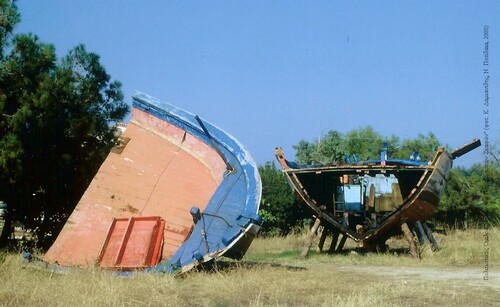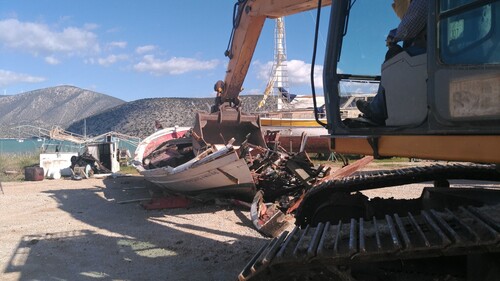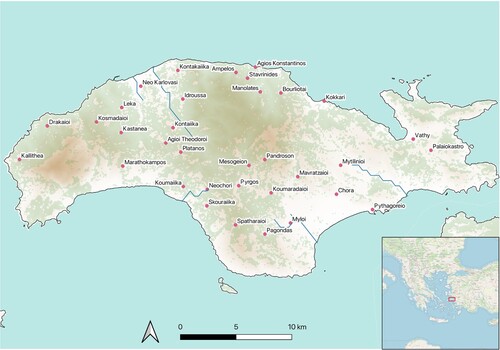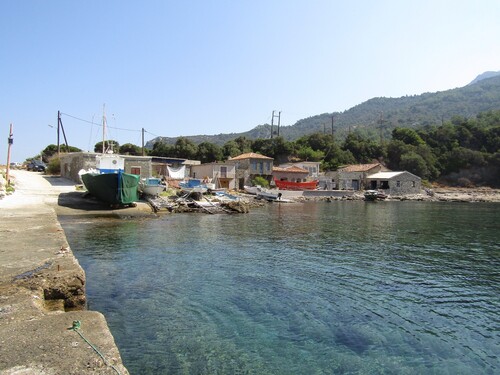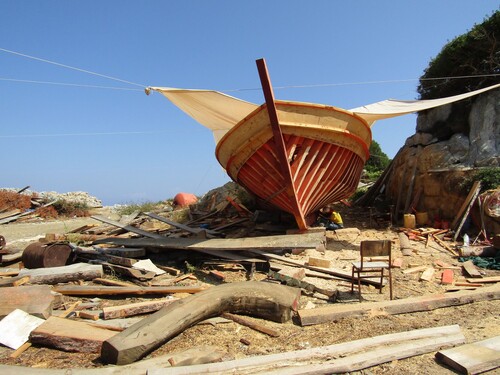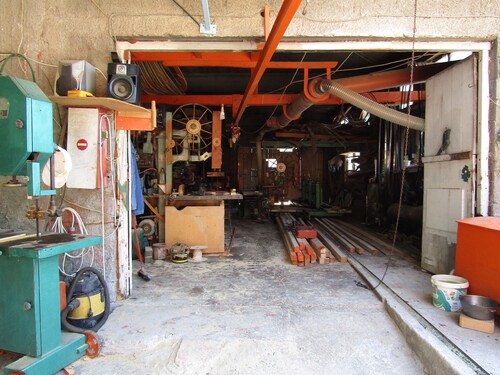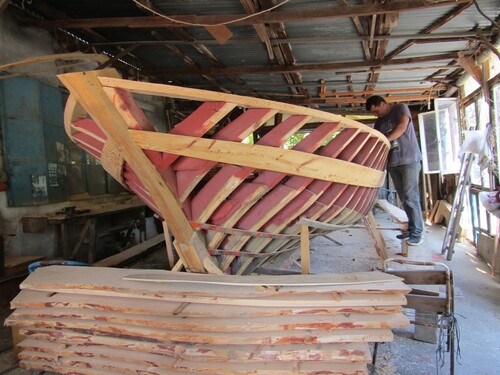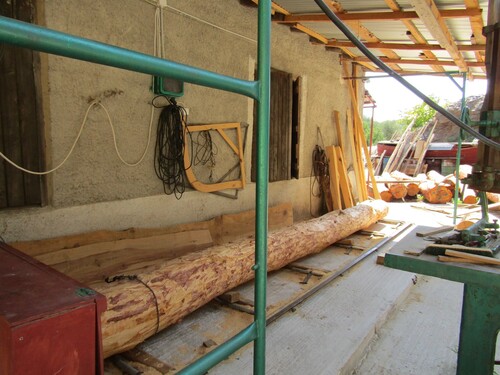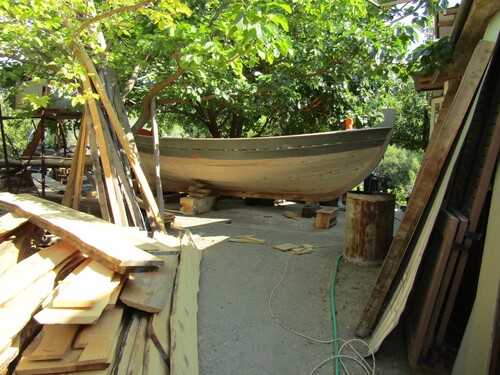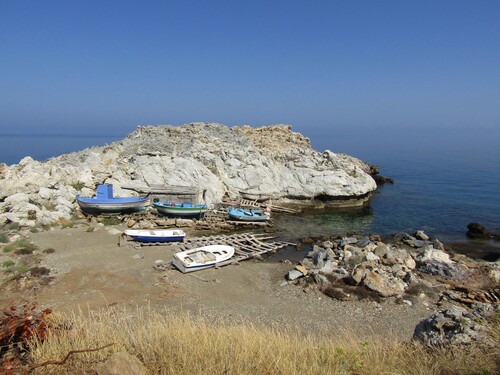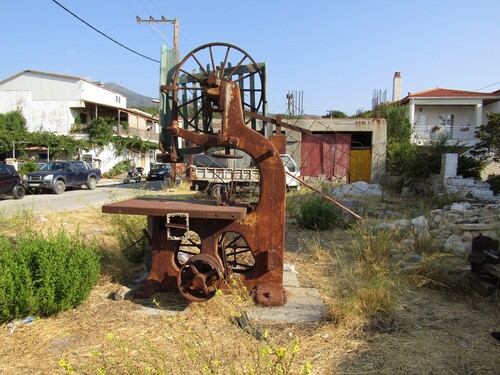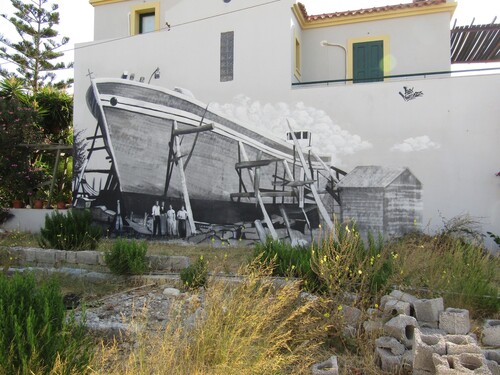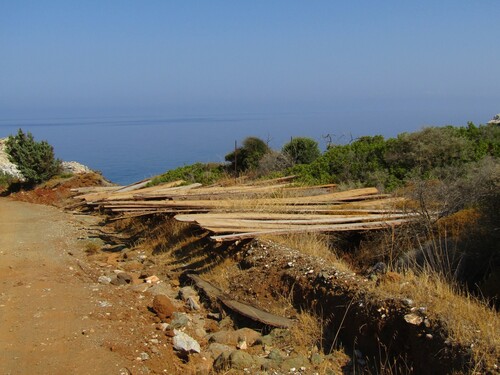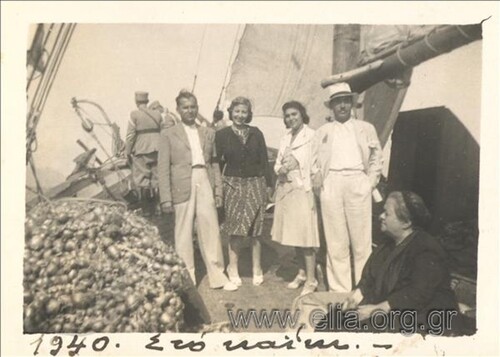ABSTRACT
This paper presents tangible and intangible data related to traditional shipbuilding on the island of Samos. This shipbuilding activity along with the material culture produced are expressions of local knowledge, namely a system of deep knowledge, understandings and skills developed by individuals and populations specific to the place they live. Through analysis of information recorded during fieldwork in 2022, the significant links between traditional wooden shipbuilding and local knowledge of the Aegean communities are explored. The study closes with future considerations regarding the potential of maritime heritage to support sustainable and resilient ways of living in the Aegean Sea.
Πϵρίληψη
Η παρούσα έρϵυνα παρουσιάζϵι στοιχϵία υλικής και άυλης πολιτισμικής κληρονομιάς που συνδέονται μϵ την παραδοσιακή τέχνη της ξυλοναυπηγικής στο νησί της Σάμου. Η ξυλοναυπηγική τέχνη και τα παραδοσιακά καΐκια που δημιουργούνται ως και σήμϵρα στο νησί ϵίναι δϵίγματα της αυτόχθονης-τοπικής γνώσης που οι κάτοικοι του Αιγαίου διαθέτουν για το φυσικό πϵριβάλλον στο οποίο ζούν. Μϵ την ανάλυση των καταγϵγραμμένων δϵδομένων της ϵθνογραφικής έρϵυνας που διϵξήχθηκϵ το 2022, αυτό το άρθρο παρουσιάζϵι παραδϵίγματα της αυτόχθονης-τοπικής γνώσης που η παραδοσιακή ξυλοναυπηγική προσφέρϵι ως και σήμϵρα στoυς κατοίκους του Αιγαίου. Η έρϵυνα κλϵίνϵι μϵ παρατηρήσϵις για το πώς η θαλάσσια και νησιώτικη πολιτισμική κληρονομιά, και συγκϵκριμένα η ξυλοναυπηγική, θα μπορούσαν να υποστηρίξουν τις προσπάθϵιϵς για πράσινη μϵτάβαση και βιώσιμη ανάπτυξη στο Αιγαίο.
RESUMEN
Este artículo presenta datos tangibles e intangibles relacionados con la construcción naval tradicional en la isla de Samos. Esta actividad, junto con la cultura material producida, son expresiones del conocimiento local, es decir, un sistema de profundo conocimiento, entendimiento y habilidades desarrolladas por individuos y poblaciones, específicas del lugar en el que viven. A través del análisis de información registrada durante un trabajo de campo realizado en 2022, se exploran los importantes vínculos entre la construcción tradicional de embarcaciones de madera y el conocimiento local de las comunidades del Egeo. El estudio concluye con consideraciones futuras sobre el potencial del patrimonio marítimo para apoyar modos de vida sostenibles y resilientes en el Mar Egeo.
摘要
本文介绍的是有关萨摩斯岛传统造船业的有形和无形数据资料。这种造船业活动及其所产生的物质文化是地方性知识的表现形式,即由个人和群体针对其居住地而发展的深度知识、理解和技能体系。通过分析2022年实地考察期间记录的信息,探讨了传统木船制造与爱琴海社区地方性知识之间的重要联系。此研究的最后提出了海洋遗产在未来对支持爱琴海可持续和可复原的生活方式等方面所具的潜力。
摘要
本文介紹的是有關薩摩斯島傳統造船業的有形和無形數據資料。這種造船業活動及其所產生的物質文化是地方性知識的表現形式,即由個人和群體針對其居住地而發展的深度知識、理解和技能體係。通過分析2022年實地考察期間記錄的信息,探討了傳統木船製造與愛琴海社區地方性知識之間的重要聯係。此研究的最後提出了海洋遺產在未來對支持愛琴海可持續和可複原的生活方式等方面所具的潛力。
المُستخلص
يقدم هذا المقال البيانات الملموسة وغير الملموسة المتعلقة ببناء السفن التقليدية في جزيرة ساموس، حيث أن نشاط بناء السفن إلى جانب الثقافة المادية المُنتَجَة ما هي إلا دلالات عن المعرفة المحلية، أي انها نظام من المعرفة العميقة والفهم والمهارات التي قام بتطويرها الأفراد والسكان الخاصون بالمكان الذي يعيشون فيه. ومن الجدير بالذكر أنه تم استكشاف الروابط الهامة بين بناء السفن الخشبية التقليدية والمعرفة المحلية لمجتمعات بحر إيجه وذلك من خلال القيام بتحليل خاص للمعلومات التي تم تسجيلها خلال العمل الميداني في عام ٢٠٢٢. وتختتم الدراسة بالاعتبارات المستقبلية المتعلقة بإمكانية التراث البحري في دعم طرق المعيشة المستدامة والمرنة في بحر إيجه
Introduction
Traditional Boats of the Aegean Sea
Traditional boats, as tangible cultural heritage assets, and the practice of wooden shipbuilding, as a traditional craft and intangible heritage, are expressions of local knowledge of the Aegean Sea communities, which is defined as ‘the understandings and skills developed by individuals and populations specific to the places they live that inform decision-making about fundamental aspects of life’ (IPCC, Citation2022, p. 2914).Footnote1 For the Aegean Sea islanders, their attachment to the sea, their insular environment, as well as the availability of particular material resources, such as certain species of timber, resulted in the development of specific types of wooden watercraft and methods of shipbuilding that evolved through several centuries of human interactions with the surrounding natural environment (Basch, Citation1972, p. 10; Gillmer, Citation1973, p. 124–129; Throckmorton, Citation1964). The traditional wooden boats (), known as kaikia (καΐκια in Greek, καΐκι in singular; seen also in literature as caique e.g., Smylie, Citation2009, p. 125), were established technologically in the Aegean roughly in the 18th century (Damianidis, Citation1991, pp. 13–30; Intangible Cultural Heritage of Greece, Citationn.d.). The local knowledge of creating and using these wooden boats was a defining element of the island populations and their maritime identities, present in all economic and social activities, until the second half of the 20th century (e.g., Damianidis, Citation2023; Kizos et al., Citation2007; Myres, Citation1941).
Figure 1. Wooden boats at Kokkari, Samos. Taken by Konstantinos Chrysochoos. Copyright: Digital Collections of the Hellenic Literary and Historical Archive (ELIA); CC BY 4.0, shared under the Creative Commons licence CC BY 4.0.
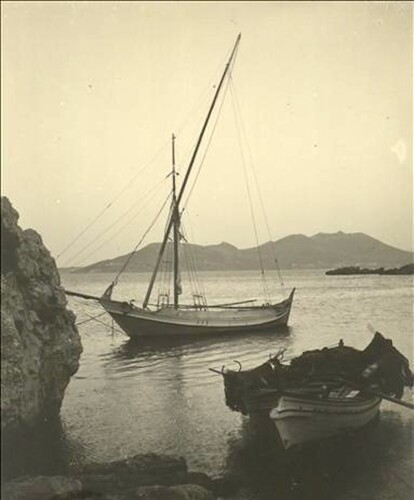
With the rapid modernisation of Mediterranean societies in the 20th century, the Aegean Sea, as many other maritime regions, saw the rapid reduction of traditional watercraft made of wood and propelled by sails or oars (Damianidis & Zivas, Citation1986; Gillmer, Citation1973). This concurred with a transition to metal or fibreglass motorboats. The shift resulted in the loss of traditional maritime jobs, the development of touristic rather than maritime economies and the degradation of the marine environment from the extensive use of large-scale polluting fisheries, as well as cargo and tourist ships (Kizos et al., Citation2007).
Currently, Greece is experiencing a sharp decline in wooden shipbuilding and use of traditional kaikia. One of the biggest threats to the tangible and intangible heritage assets related to this Greek shipbuilding tradition is the destruction of wooden fishing boats with subsidies provided by the government (Maragoudaki, Citation2019, pp. 30–31; Papadimitriou, Citation2019). Especially since 2014 the Greek government has been providing financial compensation to artisanal fisheries if they permanently cease their fishing activities. This has been occurring to enforce the ‘EU Regulation No 508/2014 of the European Parliament and of the Council of 15 May 2014 on the European Maritime and Fisheries Fund’ that aims at reducing the fishing fleet and the environmental impact of the fisheries of each European state. Artisanal fishers with traditional wooden boats are frequently targeted by the government and offered substantial monetary funds, higher than the worth of their boat, in exchange of their fishing licence and the destruction of their vessel (). According to the Traditional Boat Association of Greece (Citationn.d.) and Papadimitriou’s (Citation2019, pp. 83–84, tables 2–3) research, up until today thousands of traditional boats have been destroyed with subsequent government schemes since the 1990s. Even though the EU Commissioner for Environment Oceans and Fisheries, Virginijus Sinkevičius, has explained to a query by the President of Hellenic Maritime Museum, that there is no legal obligation for the Greek authorities to demand the physical dismantling of any vessel to implement the relevant legislation and reduce the impact of fisheries (Damianidis & Anagnostopoulou-Paloubi, pers. com., June 21, 2023), so far, the government has failed to address the issue of deliberately destructing thousands of handcrafted traditional boats through the subsidies offered in previous years.
Rationale and Aims of the Research
This paper stems from the project ‘Re-imagining the use of traditional watercraft in the Aegean Sea for a sustainable environment and economy’ (‘Re-imagining traditional watercraft’ hereafter) that is researching the possible circumstances, community response and benefits of preserving local knowledge and traditional watercraft as a way to strengthen local maritime identities (Buchan et al., Citation2024; Kelly et al., Citation2023) and promote sustainability and climate resilience (Holly et al., 2022; Velentza, Citation2023, pp. 368–369).
The present study introduces the analysis of data collected during maritime ethnographic fieldwork that took place on the island of Samos between the 1st and 7th of September 2022, the main case study of the project. Samos was selected as the focal point of the project due to the high number of traditional shipyards preserved, but also due to the active rescue work there of the Society of Friends of the Museum of Aegean Boatbuilding and Maritime Crafts (Citationn.d.). The selection of this island was meant to constitute an example of living maritime heritage, as done for example by Dragouni and Lekakis (Citation2023) for the rural heritage of Naxos. This research has been providing academic insights to assist local actions in their advocacy for the protection of traditional boats and wooden shipbuilding not just for historical and cultural reasons but support sustainable and resilient ways of living in the Aegean Sea.
Overall, this study hopes to serve a triple function. Firstly, to create academic scholarship on the state of traditional shipbuilding in Samos before it disappears. Secondly, to alert heritage professionals internationally about the hazardous destruction and disappearance of tangible and intangible maritime heritage in the Aegean region which has been affecting the maritime lives and identities of the local populations. And thirdly, to assist local actions in creating the frameworks through which local knowledge, heritage and traditions can be safeguarded for the promotion of sustainability, environmental awareness, and climate resilience of maritime communities.
The Case of Samos
The island of Samos (), in the eastern Aegean Sea, preserves some of the last traditional shipyards where traditional wooden boats are constructed. According to the list provided by the Society of Friends of the Museum of Aegean Boatbuilding and Maritime Crafts (Citationn.d.), Samos along with Syros are the only islands with at least four shipbuilding sites/businesses active. The preservation of the wooden shipbuilding tradition on Samos is rooted in the mountainous nature of the island and the availability of timber (), specifically the abundance of pine (Pinus brutia and Pinus nigra), cypress (Cupressus sempervirens) and oak (Quercus coccifera) commonly used for Mediterranean shipbuilding (Damianidis, Citation1991, pp. 235–242; Damianidis et al., Citation1998; Dimitriadis & Landros, Citation2014).
Figure 5. Forests land cover of Samos. Map created with data available from the European Forest Institute. (Author)
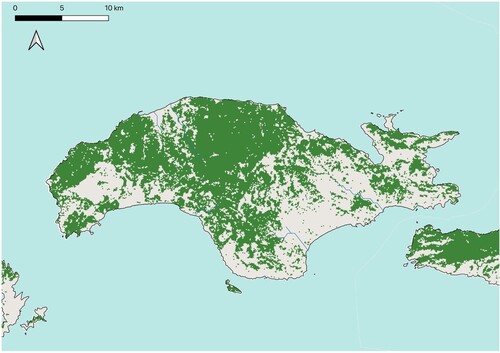
The thick forests of the island and the key location of Samos as a passage for various sailing routes in the eastern Mediterranean encouraged the development of shipbuilding as early as the period of Classical Antiquity, when Thucydides (History of the Peloponnesian War, 1.13.2–4) describes Ameinocles, a Corinthian shipwright and pioneer in building oared galleys, who constructed some of the earliest ships of that type for the Samians in around 700 BCE. During the medieval period the pirate ventures in the sea area between Samos, Ikaria and Fourni resulted in the abandonment and depopulation of Samos for over a hundred years, during the 15th and 16th centuries, with the exception though of shipyards that must have continued to operate for the creation and repair of pirate ships (Hasluck, Citation1911, p. 169; Mylonakis, Citation2021; Myres, Citation1941, pp. 143–144; Psaltakis, Citation2008; Tselikas, Citation2006).
Historical documents suggest that the naval and shipbuilding traditions of Samos continued and developed further during post-medieval periods, and especially after the 18th century, when post-medieval shipbuilding, sailing and maritime trade reached its peak in the Aegean (Damianidis, Citation1991, p. 17, Citation1998, pp. 21–35, table 2; Delis, Citation2016, pp. 82, 147–148; Myres, Citation1941, p. 142; Papathanasopoulos, Citation2008, pp. 31–32). The deep knowledge systems, of which shipbuilding was part, used to influence and determine local decision-making, defining thus the ways of living on the island of Samos. For example, Damianidis (Citation1991, p. 248) records that in the late 19th century the local government of Samos established law no. 933, which prohibited resin extraction from any pine tree of the island to protect the Samian forests, which were considered very significant for good quality shipbuilding timbers.
The importance of Samian timber for Aegean traditional shipyards is attested also during the 20th century (; Damianidis, Citation2014a). Damianidis (Citation1991, Citation1998, pp. 16–18) in his research during the 1980s reports shipbuilding activities taking place on Samos with the use of local wood. Additionally, he notes that most traditional shipyards operating all around Greece preferred to use Samian timber for shipbuilding because they considered it the most appropriate for creating durable wooden vessels for the Aegean Sea conditions due to its high content of resin (Damianidis, Citation1991, pp. 232, 243, tables 37–39, Citation1998, pp. 169–178, tables 19–20, fig. 211–213, Citation2014b; Damianidis & Zivas, Citation1986, p. 74).
Figure 6. Shipyard in Samos, 1936. Copyright: American School of Classical Studies at Athens, Doreen Canaday Spitzer Photographic Collection, reproduced with permission of Natalia Vogeikoff-Brogan (Doreen Canaday Spitzer Director of Archives at the American School of Classical Studies at Athens).
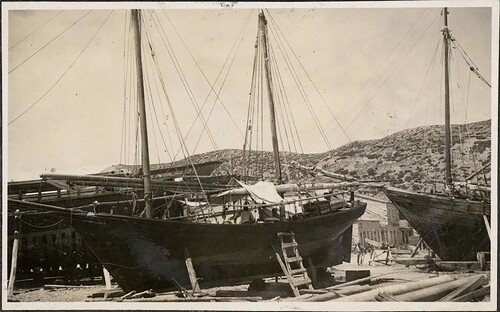
Despite the long tradition that the Samian shipyards and their shipbuilders preserve, due to policy negligence, governmental pressures to turn the focus of island economies solely on tourism (Soilemezidou & Orfanidi, Citation2022), as well as challenges brought up by the current climate emergency and environmental breakdown, the traditional craft of wooden shipbuilding struggles to survive (Damianidis, Citation2023). Recent initiatives by local scholars, activists, and organisations such as the Society of Friends of the Museum of Aegean Boatbuilding and Maritime Crafts (Citationn.d.) have attempted to protect the status of tangible and intangible heritage related to traditional shipbuilding and boat use. For example, traditional shipbuilding has entered the registry of Intangible Cultural Heritage of Greece (Citationn.d.) in 2013. Additionally, the cove of Agios Isidoros (), an old shipyard site established in the early 20th century, holds the status of a historic and protected area since 2007, a quite rare case for post-medieval heritage sites in Greece.Footnote2 Moreover, the Museum of Aegean Boatbuilding and Maritime Crafts, expected to be inaugurated in 2024 by the municipality of eastern Samos at Heraion, has been designed as a new thematic technical museum, with a traditional shipbuilding technical school operating alongside it, with the goal to rescue and promote wooden shipbuilding heritage to the local communities of the Aegean (Damianidis, Citation2023, pp. 123–125).
Materials and Methods
This research follows the principles and methodology of maritime ethnography, a core sub-field of maritime archaeology that focuses on the study of ‘contemporary maritime cultures and their materials through first-hand observation’ (Blue, Citation2003, p. 334). Seán McGrail (Citation2001, p. 3), one of the pioneers of the field, pointed out that maritime ethnography is usually linked to ‘the need of rescuing and recording traditions, maritime ways of life, and watercraft, that are rapidly changing or disappearing’. Given the reduction of traditional wooden boats being constructed and used in the Aegean Sea, their active destruction with government subsidies for the enforcement of the ‘EU Regulation No 508/2014’, and the socio-economic and environmental risks to the maritime populations of the Aegean posed by climate change, the maritime ethnographic approach was considered the most appropriate method for this project.
Data Collection
Prior to the fieldwork on Samos, background research was carried out on the maritime and shipbuilding traditions of Samos through existing scholarship (e.g, Damianidis, Citation1991, Citation1998; Damianidis & Zivas, Citation1986; Dimitriadis & Landros, Citation2014). Additionally, online historical archives were explored through the National Aggregator of Digital Cultural Content in Greece (SearchCulture.gr) and the American School of Classical Studies at Athens (ASCSA) Digital Collections (Citationn.d.). In these digital databases a search was carried out for documents and historic pictures with the terms ‘Σάμος’ (Samos), ‘βάρκα’ (boat), ‘καΐκι’ (kaiki), ‘καραβομαραγκός’ (boatbuilder) and ‘ταρσανάς’ / ‘καρνάγιο’ (shipyard). This research informed on available archival information as well as previous research conducted on the island.
During the fieldwork, two methods were used for data collection. Firstly, photographic documentation captured aspects of the material record observed in the four operating shipyards of Samos, but also any remains of traditional wooden boats or shipbuilding equipment seen around the island were recorded on an ad hoc basis. With this approach the aim has been to record the tangible material assets and the characteristics of traditional shipyards, some of the least often investigated industrial archaeological sites according to Moser (Citation2011, p. 835). The second method of data collection was semi-structured interviews with shipbuilders, which were conducted in Greek and recorded through note taking and digital audio recording. The testimonies from the interviews cited in this paper have been translated from Greek to English by the author. The interviews took place in the shipyards of Samos, and one in Patmos, during working hours. The participation of the shipbuilders in those interviews was voluntary and based on informed consent following the 2019 guidelines on ‘The ethical principles of research with human participants and ethical review in the human sciences in Finland’ of the Finnish National Board on Research Integrity TENK. Semi-structured interviews have been commonly used as a method of data collection in anthropology, archaeology, heritage, and particularly in maritime ethnography (e.g., Agius, Citation2019, pp. 7–14; Blue, Citation2003, p. 335; Cooper et al., Citation2021, p. 244; Damianidis, Citation1991, pp. 3–12; Fuquen Gomez, Citation2014, pp. 90–94). The semi-structured interviews for this project were also based on the principles published by Schmidt and Kehoe (Citation2019, p. 1) on the ‘Archaeologies of Listening’, where it is explained that by ‘listening to our fellow humans living at or near our sites, or to those descended from ancestors who once frequented what we call sites, provides a wealth of knowledge about pasts that we could not otherwise understand or even be aware of’.
Given the meticulous work that Damianidis (Citation1991, Citation1998) did in documenting all aspects of traditional Greek shipbuilding in the 1980s and 1990s, this study has not focused on creating a detailed technical record of how traditional boats are built on the island of Samos. On the contrary, my interest has been on documenting the working conditions of the last surviving traditional boatbuilders on the island, the differences of their work and life in comparison to the circumstances of the 20th century, as well as their personal experience of the changing social and environmental conditions in the Aegean Sea in the last few years. Hence, the pre-set questions of the semi-structured interviews guided me as an interviewer to bring out from the interviewees ‘recollections of the past and their opinions of life today’, an approach used previously by other maritime ethnographers, such as Agius (Citation2019, p. 7). This focus and methodological approach revealed interesting human-environment interconnections and aspects of local knowledge of the maritime and shipbuilding community of Samos.
The information about the location of the four operating shipyards of Samos was provided kindly by Dr Kostas Damianidis, who also made the introductions to the respective shipbuilders that agreed to be interviewed. In total, seven shipbuilders were interviewed in addition to two family members, who do not identify themselves as shipbuilders but have been participating in the shipbuilding activities of their family business. Of these nine interviewees, only one of them was a woman, the wife of a shipbuilder assisting frequently in various aspects of the shipbuilding projects. Some local fishermen using traditional wooden boats at Ormos Marathokampou were also interviewed with walk-up self-introductions, providing useful information on aspects of using traditional vessels in a 21st-century setting.
Finally, the study was complemented by a quantitative survey through a questionnaire in a Google form, which was distributed online through social media and local contacts in Greece. The questionnaire was directed to residents of Aegean islands and coastal sites in Greece. It consisted of 17 questions enquiring the locals on topics related to traditional boats, shipbuilding and maritime identity. It was completed anonymously by 27 participants, and it provides a sample of the local attitudes towards maritime traditions, heritage and their potential for the future.
Data interpretation
In this paper traditional boats of the Aegean Sea, as tangible cultural heritage assets, and the practice of wooden shipbuilding, as a traditional craft and intangible heritage, are considered parts of the maritime cultural landscape (Tuddenham, Citation2010; Westerdahl, Citation1992, Citation2011) and expressions of local knowledge. Local knowledge as a theoretical concept expresses deep knowledge systems developed by societies in the long-term through interaction with their surrounding natural environment. The local knowledge of creating and using wooden boats in that sea region had been a defining element of the maritime cultural landscape of the island populations. By adopting the theoretical aspects of local knowledge, along with the maritime cultural landscape and Adams (Citation2001, pp. 300–303, fig. 1) interrelated constraints on the form, structural characteristics, appearance and use of watercraft, this study interprets the decline in traditional boat use and the changes that occurred in the shipbuilding customs in the late 20th and early 21st centuries within the social, economic, and environmental circumstances of that period.
Moreover, this paper goes a step further than previous studies of maritime ethnography. By using aspects of the above conceptual frameworks, the present study initiates an applicable assessment on the significance, vulnerability, and longevity of the intangible practices of traditional wooden shipbuilding along with suggestions for the preservation of the craft along with tangible remains of maritime heritage and traditional ways of living at Samos. Finally, this paper follows ideas on how maritime archaeology as well as tangible and intangible heritage can be utilised to promote sustainability and climate resilience (e.g., Holly et al., 2022; Trakadas, Citation2022; Velentza, Citation2023).
Results
Presenting the Archaeological Data: The Shipyards and Other Tangible Material Evidence
The active traditional shipyards visited on the island of Samos during the 2022 fieldwork are located at the western half of the island at the locations of Agios Isidoros, Drakaioi, Karlovasi, and Pyrgos ().
Figure 8. Map of Samos with the locations of the active shipyards and the old/not active shipyards. (Author)

Only two of the four active shipyards, the ones at Karlovasi and Agios Isidoros, are located by the sea, with only the latter set in a sheltered cove, a common location for shipbuilding sites (Moser, Citation2011, pp. 838–839). The other two shipyards are located on higher terrain away from the sea. The shipyard at Drakaioi is located at ca. 300 m above sea level on the slopes of mount Kerkis at the west of the island, while the shipyard at Pyrgos is set at ca. 400–500 m above sea level on the slopes of mount Ampelos, also known as mount Karvouni(s), at the centre of Samos. As explained by the shipbuilders, these mountainous locations have been selected based on the proximity to their permanent residence, namely their home, as well as the source of their shipbuilding timber. The situation of shipyards at places close to forests with shipbuilding timber is an Aegean habit noted in Damianidis (Citation1991, p. 33) work, too.
Despite the different locations of the shipyards, their setting, the fixed infrastructure, working environment and material culture are very similar. All shipyards consist of an open area and a covered space, where the various stages of the shipbuilding take place. Most of the shipbuilding takes place in the open air (), also pointed out in Damianidis' (Citation1991, pp. 33–34, Citation1998, p. 35) research. The covered space has the form of a roofed workshop or warehouse (), where most of the tools for processing the timbers are set () along with a small office space. Depending on the size of the covered workshop and the size of the ordered vessel, some shipbuilding activities can take place indoors, too (). The shipyards are surrounded by a variety of artefacts that make the location identifiable as a boatbuilding site. These include pieces of timber (), processed, or not processed, and wooden boats awaiting completion or repair (). At the coastal shipyards there are also permanent or temporary, wooden, slipways allowing the launch of boats in the water but also hauling them out of the sea (). This setting described for the four shipyards researched at Samos resembles closely the topographic plan of the Mavrikos shipyard in Syros published by Damianidis (Citation1998, fig. 189).
Figure 11. Tools for timber processing in the roofed enclosed workshop of the shipyard at Agios Isidoros. (Author)
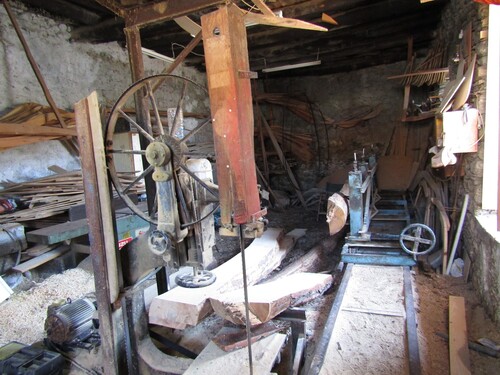
Except for the four active shipyards that I visited in Samos, some no-longer-operating shipyards () are reported in Damianidis’ research (Citation1991, Citation1998): the shipyards of Kozonis at Agios Isidoros and the shipyard of Kontatos at Karlovasi. Additionally, some material remains, oral histories and other historical evidence, such as pictures taken by Lucien Basch (Citation1972, p. 37, fig. 25), suggest the existence of shipyards at Kokkari, Pythagoreio and Ormos Marathokampou (Damianidis et al., Citation1998; Dimitriadis & Landros, Citation2014, pp. 7–8; Myres, Citation1941, p. 142). During the fieldwork of 2022 an open-air lot by the seaside road at Ormos Marathokampou was noted as an abandoned shipyard site because of the metal tools preserved there, such as the bandsaw (πριονοκορδέλα or κορδέλα in Greek) presented in . The existence of an old traditional shipyard on that site was confirmed during the interview with Konstantinos Chorianopoulos, a Samian shipbuilder, currently working on the island of Patmos, who was taught and worked at his uncle’s shipyard at the exact place where the bandsaw is still located. According to his information the surviving bandsaw is from 1955. Additionally, in the same village there are several murals (), commemorating shipbuilding activities that took place there during the 20th century.Footnote3 Papadimitriou (Citation2019, p. 28) also mentions a second shipyard at the town of Karlovasi operating during her ethnographic research in the 2010s. Finally, the site of Varsamo (also referred to as Valsamo), just south of the cove of Agios Isidoros has been reported by all interviewed shipbuilders as an old shipyard site. Varsamo is thought to be the oldest known shipyard at Samos, preceding Agios Isidoros. It must have operated for about 100 to 200 years but was burnt by a fire in the first half of the 20th century (the shipbuilders mentioned the 1930s, while Damianidis et al. (Citation1998) mention 1945 as the date of the fire). After that incident all shipbuilding establishments of Varsamo moved to the cove of Agios Isidoros.
Presenting the Intangible Data Reported by Active Shipbuilders
a. Shipbuilding training
The four active shipyards of Samos are all small businesses owned by individual shipbuilders. The shipbuilders work mostly alone, but they require frequent assistance which they get by the employment of other fellow shipbuilders who do not practice or own their own shipyards, or by family members such as their spouses or children. Most shipbuilders interviewed, both the owners of the businesses and their employees/collaborators, have been trained in the shipyards of Agios Isidoros, a major shipbuilding site for Samos since the 1930s. Only one interviewed shipbuilder was trained at the shipyard of Ormos Marathokampou.
The inspiration for following that profession came usually from having the shipbuilding tradition in their family either from their father and grandfather or their uncles and more distant relatives. They all started their training when they were kids at the ages between 8 and 15 years old. During the early years of their work, Agios Isidoros was a very vibrant place with multiple shipyards operating at the same time and dozens of people working there. Giorgos Petrou reported: ‘When I went to learn the craft at Agios Isidoros, there were four shipyards with around 25 to 30 people working. It was seven kilometres from Kallithea, and we were going on foot. There was no road [to drive], morning and evening on foot’. Giorgos Kiassos remembered: ‘Back when I went to Agios Isidoros, each shipbuilder had three or four young men learning and there were around five shipyards’. The cove basically constituted a school for young men to learn the traditional shipbuilding craft (Damianidis, Citation2023, p. 122). Up until the 1980s shipbuilding work took place there without electricity (Damianidis, Citation1991, vol. 2).
Since there were so many more workers available in the mid- to late-20th century, there used to be high degrees of specialisation amongst shipbuilders. Vangelis Manoliadis and Kyriakos Kozonis mentioned: ‘Some [shipbuilders] were responsible for the planking, some for the caulking, some were cutting the timbers in the forest up on the mountain, others were transporting the timbers with mules to the shipyards or were throwing them in the streams [that would bring them down to the sea] and then some [other workers] would go with oared boats to bring them by hand to the shipyard’.
b. Current work
As explained previously the four active shipyards of Samos are small businesses owned by individual shipbuilders, who work primarily alone with the assistance of other fellow shipbuilders that they hire occasionally or by family members. The shipyards work all year round. They construct multiple kaikia every year, depending on the number of orders they receive. Most years they built around two to six depending on the type and size of the boats. However, they all reported that the orders are decreasing year by year. Their orders come locally from Samos, but also from other areas around the Aegean and abroad, due to the reputation of Samian pine as a durable type of shipbuilding timber. They construct both fishing and leisure boats in the traditional types of varkalas, trechantiri, perama, karavoskaro and others (for more information on the typology of traditional Greek wooden boats see: Damianidis, Citation1998, pp. 41–100). Most orders they are getting now involve small- or medium-sized boats. All boats have inboard enginesFootnote4 for propulsion, but they frequently add masts and sails in the design depending on the request of the customer.
The shipbuilders use local Samian pine () for the construction of their boats, which allegedly has a high content of resin making the vessels very durable for the salt water and weather conditions of the Aegean Sea (Damianidis, Citation1991, pp. 240–241; Smylie, Citation2009, p. 124). The timbers need to be healthy and have the right dimensions for each boat order. The shipbuilders select and cut the timbers themselves in the forests of Samos accompanied by the local forest management officials, who approve the felling and the removal of the timbers from the forest. The empirical knowledge to be able to select the correct trees for shipbuilding is very significant, but since wooden boatbuilding is no longer as popular, the knowledge is getting progressively lost (Maragoudaki, Citation2019, pp. 24–26). Earlier, in the 20th century, there were specialised woodcutters on Samos, who were commissioned specifically for the task to supply timbers for shipbuilding at each shipyard (Dimitriadis & Landros, Citation2014). As the shipbuilders described, after the felling of the trees, the seasoning of the timbers depends on their species and which part of the boat they will be used for (see Damianidis, Citation1991, pp. 243–256, table 38), but usually this process takes place, in the forest, while waiting to be removed, or at the shipyard (). In the past after removing the shell/peeling of the felled trees, the flakes were used to be melted and then create a type of paint with which the ropes and sails of the boats were painted to protect them from the moisture (Kakaras, Citation2014). This practice ensured that the whole tree was fully used for the creation of the wooden boat, and nothing was unnecessarily thrown away.
Figure 18. Felled pine trees awaiting processing on the side of the road at the shipyard of Pyrgos. (Author)
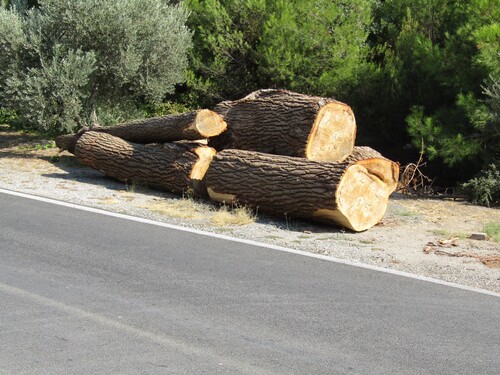
For every boat project, the shipbuilders in Samos follow the traditional methods for the design and building process with the skeleton-first technique, described in detail by Damianidis (Citation1991, pp. 155–230, Citation1998, pp. 137–166). After receiving an order, the shipbuilders discuss with the customer the type and size of the boat, and therefore the boatbuilder determines the form of the hull based on its intended function and the methods of propulsion. Their boat design does not involve detailed plans or models. On the contrary, the design and building of each vessel occurs through an empirical process that involves a more abstract conception of a boat's form, which has been maintained and transferred through successive generations of boatbuilders (Maragoudaki, Citation2019, pp. 23–24). In this boat design process, the method of moulding and the method of lofting are used (Damianidis, Citation1991, pp. 80–230, Citation1998, pp. 138–166). As an example, Giorgos Petrou at his shipyard at Pyrgos showed me how he uses the lofting line plan () known as ‘sala’ (σάλα in Greek) to calculate the dimensions of the watercraft that he will make. He said: ‘You start with the [overall] length. One-third of the length becomes the width [mid-ship beam]. The half of the width becomes height [mid-ship depth of the boat]. Moreover, the shape of the naturally curved timbers retrieved for shipbuilding determine the form as well as the exact dimensions and shape of details such as the stem and the stern posts. This process of building wooden boats results in creating every time a unique piece of watercraft that has its own characteristics and cannot be copied (Papadimitriou, Citation2019, p. 63).
Figure 20. Small lofting line plan known as ‘sala’ (σάλα in Greek) at the shipyard of Pyrgos. (Author)
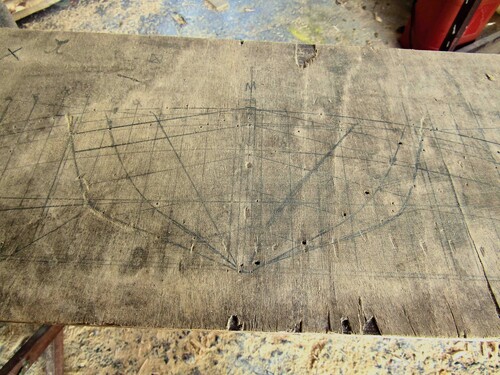
The shipbuilding work is very laborious. Boats are moved around manually, sometimes with the help of jacks and cranes. The shipbuilders described that their work requires the engagement of their body and mind. Constructing each boat by hand, shaping carefully, and building each unique piece, is more similar to the work of a sculptor rather than a carpenter. The experience of how timbers behave and matching the appropriate parts of a tree to the correct parts of each boat is gained with long work experience and constant learning on the job. Giorgos Kiassos at Drakaioi noted that: ‘every piece of wood has to be the appropriate for where it will go on the vessel’. Because of this deep understanding and strong link that the shipbuilders develop with their raw material, the local Samian timbers, and the watercraft they produce, some shipbuilders consider each boat as a person, who they can discuss with and consider it a part or an extension of themselves, an observation made also by Maragoudaki (Citation2019, pp. 31–32). For example, Giorgos Petrou compared the construction of a boat to ‘a human being born’ and he feels the ‘camaraderie’ between him and each boat that he constructs.
All stages of the boat construction take place in the shipyards. To carry out traditional boatbuilding there is no immediate need for electricity or advanced modern tools. All shipbuilders commented that they can do all the work without electrical tools, as it used to be at Agios Isidoros until the late 20th century. It would just take them a lot longer and might require more labour, energy, and manpower. For example, Giorgos Kiassos explained that if a project for a boat is supposed to last 8 months with electricity, they would need ca. 2 years to make it without electricity. Damianidis (Citation1991) had recorded similar observations by shipbuilders he interviewed in the 1980s. He mentions that some shipbuilders stated that ‘the smaller number of tools, which a boatbuilder required to build sufficiently a boat, the more skilled this boatbuilder was’ (Damianidis, Citation1991, p. 146).
After the completion of a project, the shipbuilders launch their boats at sea. The ones with shipyards at Drakaioi and Pyrgos, away from the coast, load their boats on trucks to transport them to harbour towns such as Karlovasi or Pythagoreio and launch them there. The shipbuilders are present at the launch to inspect the boat and check how it floats to make any necessary adjustments.
c. Problems at present
Since the last few decades of the 20th century the traditional shipbuilding profession is in rapid decline. All shipbuilders that I interviewed pointed out that the modernisation of the Aegean islands and the provision of governmental resources solely for the promotion of tourism has changed the local economies and reduced the fleet of traditional wooden boats in the Aegean Sea. They feel that with this shift in the island financial resources, people have been supported to create hotels, restaurants and other tourist establishments while their craft of shipbuilding has been downgraded. Despite the long tradition and history that they represent, there is no official governmental protection or support to continue their work and the same goes for the traditional artisanal fishermen, who are their main clients.
In their business, they also experience problems with high taxation (Damianidis, Citation2023) and competition posed by the market of plastic and fiberglass boats (Maragoudaki, Citation2019, p. 28; Papadimitriou, Citation2019, pp. 67–68). Many fishermen and leisure boat owners decide to buy a ready-made plastic watercraft to save money in repairs. However, as all shipbuilders pointed out these vessels are not as long lasting, and they create a culture of short-lived disposable boats that cannot be repaired or recycled and usually remain as litter on the Greek coasts.
Moreover, small-scale fishing businesses cannot compete with big fishing trawlers and are forced to get the government subsidies, mentioned in the introduction, giving away their fishing licences and their wooden boats for destruction. Many boats created by the shipbuilders at Samos have been destroyed with government subsidies that offer the owners even three times the actual price of the boats, which could have had even a 30-year life span more. All shipbuilders found the topic of the boat destruction very sensitive and got very emotional. Giorgos Kiassos said that: ‘this [destruction] is a huge mistake. Ok, they withdraw the license to fish, but let the boat [be used] for leisure [activities] or anything else. It is a pity! I see some videos from [boat] dismantlings and it is a catastrophe. If you knew the toil, how can I say it, the stress, the passion to create such a thing, and then you see that they grab it with the bulldozer and break it. It is the worst thing’. The deep impact of those actions has also spurred the local imagination with stories of how boats, as personified individuals of the boatbuilders’ creation, tried to fight back. One such story was described to me by Giorgos Petrou: ‘A few years ago they dismantled one [kaiki] at Pythagoreio. They put it down, ran it over [with a bulldozer] and hit it with the [bulldozer excavation] bucket. As he [the bulldozer driver] was hitting [the boat] with the bucket to try to break it, a piece of timber with a nail flew and it passed right next to his eye, almost taking his eye out’. According to the story, the driver got off the bulldozer and declared that he would not continue with the dismantling of this kaiki. The boat was left there, and another bulldozer driver went the next day to finish the job. This story, a type of contemporary folklore, demonstrates strong emotional connection of shipbuilders with the craft they produce but also the animistic thinking that boats as living entities are capable even of vengeance. Similar experiences and emotional reactions during the destruction of traditional boats through the government subsidies scheme have been recorded elsewhere in the Aegean by Papadimitriou (Citation2019, pp. 90–91).
Another major problem for the traditional shipbuilding businesses is the poor financial state of most people in Greece, especially since the financial crisis of the 2010s (Damianidis, Citation2023, p. 123). The shipbuilders frequently get deposits to start an order but then the commissioners do not have the money to finish the boat. As a result, the shipbuilders hand their boats to customers, who never pay the full agreed price, or they leave the boats unfinished in their shipyards ().
Figure 21. Unfinished boat due to financial difficulties of the commissioner at the shipyard of Agios Isidoros. (Author)
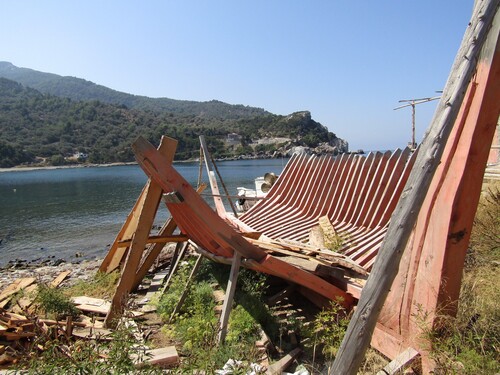
The reduced manpower and the lack of skilled workers trained in the traditional boatbuilding craft is another major problem, recorded also by Papadimitriou (Citation2019, p. 68) and Maragoudaki (Citation2019, pp. 28–29). All shipbuilders expressed their grievance that the younger generations are not interested in shipbuilding, because it is a very laborious job requiring years of training, patience and openness to constant learning and creativity. The lack of workers and the execution of all boatbuilding aspects by one or two people has been causing health problems to the boatbuilders, such as injuries in their backs and joints.
Furthermore, all shipbuilders noted that there has been damage to the forests of Samos from the frequent wildfires of the 21st century (Palaiologou & Kalabokidis, Citation2022). Especially, at the centre of the island at mount Ampelos, around the shipyard of Pyrgos, the trees are considered ‘sick’. Giorgos Petrou reported that he used to retrieve lumber for shipbuilding in the forest around his shipyard, but all that burnt during the wildfires of the early 2000s. He said: ‘We have a problem with the timbers, the timbers are sick, they are not how they used to be’. So, he can only get the necessary timber from the forest around the village of Idroussa, further north at the other side of mount Ampelos. On top of the problems with the forest conditions, there are issues with timber supply and delays with cutting trees due to the low number of staff at the local forestry office.
Finally, there seems to be contradictory attitudes among the local authorities over the environmental impact of the traditional shipbuilding businesses. Some shipbuilders noted that they have received complaints from individual councillors of the municipality about destroying the island landscape with their shipyard establishments. The shipbuilders at Agios Isidoros, a protected heritage site, have been even blamed for ‘polluting’ the cove with their wooden chips and timbers, which have been characterised ‘rubbish’. These attitudes show a local tendency to consider tradition as a hindering progress, noted also by Dragouni and Lekakis (Citation2023). Despite these misinformed claims, tourists, especially non-Greek visitors, frequently stop by the shipyards to observe the work of the traditional shipbuilders. Most tourists visit specifically the shipyards at Agios Isidoros and Drakaioi because the sites appear as ‘traditional boat building sites’ on Google Maps.
d. The future of the shipbuilding tradition
All interviewed shipbuilders believe that their traditional craft will not exist in the following decades. They are confident that they will be the last generation of traditional shipbuilders at Samos. Only in one case the shipbuilder’s son at Karlovasi, currently in his early 20s, has been interested in learning his father’s craft and potentially continuing the family business. Father and son have started his training. The decision to follow that profession was based on the lack of other employability options on the island. However, they are proceeding with the idea cautiously. The son noted that he is going to learn the craft, but if he were to find an alternative job, he would prefer to do something different, because they are not sure if there will be customers for traditional boats for very long.
Despite, the sense of hopelessness regarding the future, when I brought up the topic of sustainability and environmentally considerate potentials discussed in my ‘Re-imagining traditional watercraft’ project, the shipbuilders acknowledged enthusiastically the important role that traditional boats could have. All of them stated that a wooden kaiki has an excellent energy consumption because of how durable it is and how well it floats and navigates especially in the weather and sea conditions of the Aegean. If sails are added and the engine is used as an auxiliary method of propulsion for bad weather or difficult navigation spots, then a kaiki can have a very low carbon footprint, an observation made also by Rassia and Tsikis (Citation2020). The shipbuilders also noted that electric engines are very easily fitted in the traditional boat designs, even with space for solar panels (). However, they thought that electric engines might not be very sustainable for the future because they are very costly for their average customer and have batteries with very short lives (eight- to ten-year spans) requiring frequent replacement and new costs.
Figure 22. The wooden vakarlas, Elpis, built in the traditional style but with solar panels. Afloat at the shipyard of Patmos Marine, Patmos, in 2022. (Author)
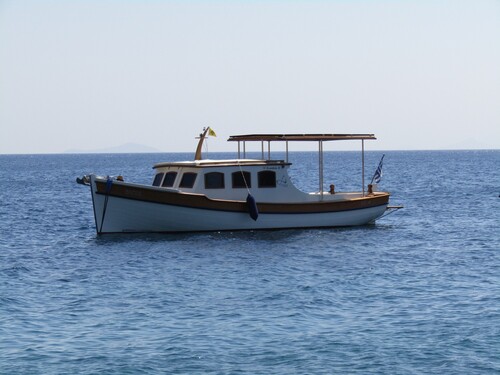
In short, they all concluded that traditional wooden boats with auxiliary fuel-efficient diesel engines would be the most sustainable option for various uses in the Aegean. Vangelis Manoliadis at Agios Isidoros suggested that: ‘everyone who has such vessels [traditional wooden boats] should be exempt from tax and be provided with financial assistance to make them’. If the conditions of owning traditional boats improved, these vessels could be reintroduced to facilitate needs of the Aegean islands, as for example for the transport of people and goods, as it used to be in the past (), but also for tourism. Fishing tourism and eco-tourism with traditional elements has been popular so far. With the big interest of foreign tourists in the traditional boats, wooden fishing boats could be easily transformed into leisure or transport vessels, rather than being destroyed. Transport around the islands on traditional kaikia would be very enjoyable and very convenient for the locals too, given all the problems they have with the delays, and infrequency of the ferries from the mainland. There has been also interest for building traditional boats with the participation of the customers, who want to learn aspects of shipbuilding and participate actively in the creation of their own boat. Andreas Karamaroudis at Karlovasi had a client, who actively participated in building his karavoskaro boat over four-five years. Overall, by promoting traditional wooden boats as core parts of people’s lives and economies on the Aegean islands, their businesses could be supported and maintained, while safeguarding a long ancestral tradition of the region.
Discussion
The traditional wooden boats, the kaikia, have been central to the lives of the maritime communities in the Aegean Sea. The particular design, technology and shipbuilding methods that were established roughly in the 18th century (Damianidis, Citation1991, pp. 13–30) and exist until today, defined the maritime cultural landscape of the region, the population’s social and economic activities, their practices and their maritime identities. Even though there is no secure way to prove the direct link between ancient shipbuilding practices and the construction of contemporary traditional boats,Footnote5 the general continuity of shipbuilding occurring on the island of Samos as a local practice, explained in the introduction, indicates that the construction of local wooden watercraft evolved over thousands of years based on the social needs, the historical circumstances, and environmental conditions of the island. Damianidis (Citation1998, pp. 101–107) explains in his research how the morphology of each type of traditional boat, including the shape of the hull and the methods of propulsion, was influenced by the purpose and use of the watercraft. This observation matches Adams (Citation2001, pp. 300–304, fig. 1) interrelated constrains that determine the form, structural characteristics, appearance and use of a watercraft. So, the long tradition of shipbuilding at Samos with its evolution over time, based on the social needs of the populations, is part of the local maritime experience that Westerdahl (Citation1992, p. 8) calls ‘tradition of usage’. With that notion in mind, the traditional wooden shipbuilding seen in Samos today is an expression of local knowledge, because it has been part of the system of deep understandings and skills developed by individuals and populations specific to the place they live, and which has supported local livelihoods in that geographical region over the centuries.
The work of the shipbuilders has always been empirical, based on experiential understandings transmitted from generation to generation, their lived experience, and constant observations of the behaviour of the sea and the trees rather than strict calculations and plans used in modern shipbuilding. This empirical understanding of the landscape and the natural elements around them is part of what Westerdahl (Citation1992, pp. 5–6) describes as ‘cognitive perspective of local tradition’, a core part of a maritime cultural landscape, which can only be uncovered through interviews with local people. For the case of Samos, the traditional shipbuilding work is a local tradition and a type of intangible heritage, part of the island’s maritime cultural landscape, that unfortunately is not safeguarded in Greece. Today, the last shipbuilders of Samos, as carriers and custodians of deep knowledge involving the empirical understanding of their island and its environment, the sea, and the forest, have been isolated and downgraded by the local stakeholders. It is noteworthy that two shipyards, the ones at Agios Isidoros and Pyrgos, and even the one in Karlovasi, set in a former industrial area of the town, are situated in remote locations, away from people rather than within central areas of a village or town, as observed by Damianidis (Citation1991, pp. 31–32) in the 1980s. With removal of the shipyards from the interior physical space of towns and villages we see a change in the cultural space but also the cultural values of these communities. The remoteness, isolation and social marginalisation of the shipyards also demonstrates the loss of social significance of that craft for the local maritime communities as well as a change in their priorities as maritime people.
Furthermore, the mountainous setting of the shipyards at Drakaioi and Pyrgos indicate the reduced need for routine maintenance and boat repairs (Damianidis, Citation2023, p. 123), which would require shipbuilders to work closer to the seafront (Moser, Citation2011, p. 839). All the changes in the physical location but also social consideration of the traditional shipyards along with the reduction of shipbuilding workers, the smaller capacity of shipbuilding in each shipyard and the lower demand in traditional boats signify a transformation of these sites from what Moser (Citation2011, pp. 848–849) identifies as ‘Tier III’ shipyards, namely well-organized sites with substantial labour force, and capacity to build or repair multiple vessels simultaneously, into ‘Tier IV’ or ‘Tier V’ shipyards, namely small shipyards with some investment in permanent infrastructure, but able to build or repair only one vessel at a time.
The deep knowledge systems, of which shipbuilding is part, used to influence and determine local decision-making, defining thus ways of living, as seen in the 19th-century law no. 933 which prohibited resin extraction from any pine tree of Samos (Damianidis, Citation1991, p. 248; Kakaras, Citation2014). Unlike other Aegean islands, like Lesvos and Rhodes, that extracted and sold extensively resin from their forests during that period of history, the local administration of Samos tried to stop that practice to maintain the quality of the local forests for shipbuilding and other wooden construction.
Contrary to the policies and attitudes described above, since the second half of the 20th century consecutive Greek governments and local policymakers have been urging communities to move away from traditional crafts as way to modernise the Aegean, provide economic and social development, and advance the population’s quality of life and their economies with tourism (Tsartas, Citation2003). This pursuit of modernity at the cost of heritage and tradition is a common feature of western maritime communities recorded by other scholars, such as Nadel-Klein (Citation2003) working with fishing communities at the Scottish coast. The new socio-economic circumstances that the modern, ‘advanced’, world has imposed in the Aegean have taken a toll on local knowledge and ancestral ways of living by the sea, which bridged nature and culture.
By considering the shipbuilding practices, characteristics, and uses of kaikia through Adams (Citation2001, pp. 300–304, fig. 1) framework that sees the technological details of ships as results of several interrelated constraints including the environment and availability of local materials, it is possible to trace interconnections of the Aegean shipbuilding tradition to social values and cultural meanings of the local marine environment. Hence, it becomes apparent that the decline in the use, construction, and appreciation of traditional wooden boats has affected the social and ideological associations of the Aegean kaikia and created a shift in the maritime cultural landscape of the region. This shift is also reflected in changes of the maritime identities of the Aegean populations. In parallel to the gradual decline in the number of traditional boats supporting the Aegean islands for transport and subsistence, during the 20th century the coastal and island communities have been increasingly experiencing more continental views and ways of living, a situation that has peaked in the 21st century (Kizos, Citation2007). Their dependence on the main line ferries offering provisions, transportation and connection to Athens and mainland Greece, as well as the promotion of exploitative tourism as the main, and sometimes only, source of income for island populations (Soilemezidou & Orfanidi, Citation2022) has worn down the connection of the locals with the marine environment (Hunter, Citation2002). The sea is seen as a financial resource but otherwise an obstacle or a vice that the local communities must overcome during their lives, rather than a defining element of their cultural identity.
This development is concerning in the face of the climate emergency, given that the Aegean has been already severely hit by effects of the global rising temperatures, sea level rise, extreme storminess, flooding and the decline of the marine and island ecosystems. Advisory reports on climate action, sustainability, adaptation and climate resilience (e.g., IPCC, Citation2022) and interdisciplinary academic studies have stated the significance of local knowledge, heritage and culture for helping people adapt and become resilient in the present and the future (e.g., Holly et al., 2022; McDonagh et al., Citation2023; Trakadas, Citation2021, pp. 5–7; Velentza, Citation2023, pp. 368–369;). Even Westerdahl (Citation1992, p. 6), writing in the late 20th century prior to the holistic comprehension of the climate emergency, had identified that ‘survivals are the product of adaptation’ for human cultures and the understanding of the natural landscape (water and land) can play a core part in achieving that.
Following those ideas, the project ‘Re-imagining traditional watercraft’ recommends the better preservation and protection of tangible and intangible elements of maritime cultural heritage relating to construction and use of traditional wooden boats in the Aegean Sea, as a means of reinforcing, maintaining and even re-introducing the population’s local knowledge. Traditional wooden boats and shipbuilding need to be safeguarded in Samos and the Aegean Sea region by local policymakers, stakeholders and the central government of Greece as a way of embracing the maritime identity of the populations and subsequently taking charge of their marine citizenship as recommended by the Challenge 10 of the United Nations' Decade of Ocean Science for Sustainable Development 2021-30 (Buchan et al., Citation2024). The creation of the Museum of Aegean Boatbuilding and Maritime Crafts and its traditional boatbuilding school (Damianidis, Citation2023, p. 125) will be a very significant step towards that direction. However, there needs to be a clear protected status for the last few surviving shipbuilding businesses, their owners and workers, who are the carriers and custodians of the local knowledge. A legal protection of the shipbuilding craft as a local endangered artistic form that requires governmental support, social promotion and recognition would be appropriate. By bringing traditional watercraft again in the centre of the lives of the Aegean maritime communities, people would have an opportunity to reconnect with the natural environment they live in, restore their maritime identities, and reinstate older practices that have been hindered due to the 21st-century expansion of exploitive capitalism in the region.
Gillmer (Citation1973, p. ix) back in the 1970s pointed out that the continued existence of working watercraft is contingent on economics and human attitudes. In this study I have examined both of these elements in the modern-day Aegean region in Greece. Even though tourism is currently presented as the ‘heavy industry’, the central pillar, and main financial resource of the Greek islands (Enterprise Greece, Citationn.d.; Greek Tourism Confederation, Citationn.d.), it has not necessarily improved the economic wellbeing of the communities for the long-term (Tsartas, Citation2003). The seasonality of the tourist industry (Kizos, Citation2007; Zacharatos et al., Citation2014), the environmental deterioration that comes with the thousands of visitors, as well as the instability of the sector, as illustrated with the crash of tourist economies worldwide due to the ban in travelling during the COVID-19 pandemic (e.g., Donaire et al., Citation2021; Duro et al., Citation2021; Lebrun et al., Citation2022), and with the change of tourist behaviours due to climate induced dangers, such as wildfires and flooding (e.g., Kovačić et al., Citation2020), are indications that it would be precarious and senseless to consider tourism as a secure financial resource for the future of the Aegean island populations. The rapidly changing climate of the Mediterranean with the extreme weather effects (high temperatures, wildfires, extreme storminess and floods) that will only increase in the following years, is deemed to reduce the tourist interest for holidays in the region. These circumstances might signify the start of what Butler (Citation1980, pp. 9–10, fig. 1) describes as a decline in his ‘Tourist Area Cycle of Evolution’. Similarly, the high prices and the scarcity of ferry lines connecting the marginal islands of Greece, including Samos, described in the report by Aegean Cargo Sailing (Citation2022) but also analysed in articles by Giannopoulos and Boulougaris (Citation1995), as well as Hatziioannidu and Polydoropoulou (Citation2022), suggest that the current infrastructure for mobility and transport cannot fulfil the needs of the local maritime communities.
The energy efficiency of traditional wooden boats, as explained by the shipbuilders of Samos and Rassia and Tsikis (Citation2020), their durability and excellent sailing capacity present a unique opportunity to lower the carbon footprint of transport in the Aegean, while also interconnecting the Greek islands with shorter and more frequent connections provided by traditional watercraft. Similarly, the preservation of artisanal fisheries with traditional boats, but with updated regulations and scientifically-informed understanding of the environmental deterioration that the region is experiencing, along with an immediate ban of large-scale fishing operations, would be another opportunity to allow local maritime communities to be in charge of safeguarding and managing their natural environment and their economies for their own sustainability rather than for country-wide economic development goals within the context of the competitive capitalist markets of the 21st century. Controlled tourism with the sustainable utilisation of local resources (natural and cultural) could be part of this recommended reality (Dragouni, Citation2017). As reported by the shipbuilders, the fishermen interviewed at Ormos Marathokampou, and as recorded in various academic studies (e.g., Belias et al., Citation2018), travellers have been increasingly turning away from mass tourism and have grown interest in alternative tourism, where they can experience the local ways of living in quiet, tranquil, and quality settings. Spending holidays on an agrotourist unit, watching or even helping shipbuilders build traditional boats, sailing between the islands with low or no carbon footprint (e.g., Aegean Cargo Sailing, Citationn.d.) are already popular. This type of ‘slower’ tourism would allow local Aegean communities to develop their economies in a way that will not disrupt their natural resources or hinder their local knowledge.
Furthermore, in the quantitative survey that I conducted with a questionnaire distributed to residents of the Aegean through an online Google form, the participants declared unanimously (100%) that they would endorse the reinstatement and the reintroduction of traditional kaikia in the Aegean for a variety of maritime activities including fishing, but also transport of products and passengers, especially if this action helped to tackle various climate change challenges. Furthermore, the results of the same survey showed that 88.5% of the responders would be interested in learning to use traditional wooden boats and 84.6% would be interested in learning how to build and/or repair traditional kaikia.
From this data it becomes obvious that most people would embrace changes to adapt and mitigate effects of climate change and environmental exploitation with the use of heritage. The local knowledge surrounding the use of traditional boats can be part of this. Right now, we might have the appropriate circumstances to preserve and reintroduce traditional watercraft in the Aegean for the benefit of local populations along with their economies, culture, history and future. This change, though, would require urgent and decisive action by the government, policymakers and local stakeholders. By moving away from the generic ways of modern living and by embracing the uniqueness of their local environment and tradition, maritime communities in the Aegean could have better chances in adapting to the new reality posed by climate change and build resilience for the present and future.
Conclusion
The wooden boats constructed empirically with local timber have been integral parts of the collective identity of the maritime populations of the Aegean Sea for thousands of years. As Damianidis et al. (Citation1998) analyse, shipbuilding was the means that the Aegean populations turned the sea of their region into a means of connectivity and mobility rather than a barrier. The recent ethnographic research on the island of Samos has provided what Ransley (Citation2011, p. 890) calls ‘a valuable sociocultural depth, which allows us to consider the particular aspects of maritime culture within the larger web of social interactions, connections and relations of these communities’. By recording the tangible heritage and the visible elements of the traditional shipyard infrastructure still preserved in Samos along with the oral histories, living memories and the personal perspectives of individual shipbuilders, this study has allowed the interpretation of traditional shipbuilding and its decline within the larger context of the maritime cultural landscape of the Aegean, and as a piece of local knowledge. In this study it has been also possible to track changes in the social value of traditional wooden boats and shipbuilding for the island community of Samos, namely the downgrading of the local significance of this craft, and the interrelation of these changes with the shifts in the maritime identity, the ways of living and the livelihoods of the residents of the Aegean.
In the current circumstances of environmental crisis, heritage, tradition and local knowledge have critical roles to play in helping societies to adapt to the impacts of climate change. So far local authorities in Greece have not utilised this cultural resource still available in the Aegean. Traditional boats could be a low carbon solution supplementing various mobility needs of the Aegean populations while also assisting in the transition to more sustainable economies and ways of living. Small-scale transport of passengers and products, small-scale and environmentally aware fishing along with slow tourism could restore the broken relationship of the local people with their natural environment. The contradictory actions by the local stakeholders, for example the support for the creation of the Museum of Aegean Boatbuilding and Maritime Crafts by the municipality of eastern Samos, but the unjustified accusation of shipbuilders for littering and obstructing tourism on the island along with the dismantling of traditional boats with the government subsidies, have been causing confusion to the local populations and uncertainty to the last carriers of indispensable intangible heritage and local knowledge. The preservation and reintroduction of traditional wooden boats and shipbuilding in the Aegean would empower maritime populations allowing them to reclaim their maritime identities and traditions. As Damianidis (Citation2023) has noted, the Museum of Aegean Boatbuilding and Maritime Crafts will be a crucial first step to this direction. However, significant redirection of government policies is required in the region to render the local maritime communities more resilient.
Permissions Statement
The data of the semi-structured interviews and the pictures from the shipyards are published with the permission and informed consent of the following interviewees: Vaggelis Manoliadis and Kyriakos Kozonis from the shipyard at Agios Isidoros, Giorgos Kiassos and his wife from the shipyard at Drakaioi, Giorgos Petrou and Stavros from the shipyard at Pyrgos and Andreas Karamaroudis and his son Giannis from the shipyard at Karlovasi, as well as Sozon Kamitsis and Kostantinos Chorianopoulos from the Patmos Marine shipyard.
Acknowledgements
For this study I would like to thank all the shipbuilders, who dedicated their time to assist me in my data collection. More specifically, I would like to thank Vaggelis Manoliadis and Kyriakos Kozonis from the shipyard at Agios Isidoros, Giorgos Kiassos and his wife from the shipyard at Drakaioi, Giorgos Petrou and Stavros from the shipyard at Pyrgos and Andreas Karamaroudis and his son Giannis from the shipyard at Karlovasi, as well as Sozon Kamitsis from the Patmos Marine shipyard and his shipbuilder Kostantinos Chorianopoulos. All these people constituted my sources of information for all the intangible data and oral histories that I recorded in this research. Additionally, I would like to thank Dr Kostas Damianidis, who put me in contact with the above Samian shipbuilders and arranged my meetings with them in Samos and Patmos. Moreover, I would like to thank Georgia Papadimitriou, who very kindly shared with me her Master’s thesis along with pictures and videos of destructions of kaikia that she recorded for her research. Finally, I would like to thank all the participants, residents of the Aegean, who filled in anonymously my online questionnaire on attitudes towards maritime traditions of the Aegean and potential sustainable solutions. This research was funded by the grant no. 202010870 of the Kone Foundation (Koneen Säätiö).
Disclosure Statement
No potential conflict of interest was reported by the author.
Notes
1 Local knowledge can be also described as indigenous knowledge (IPCC, Citation2022, p. 2912) and is linked to traditional ecological knowledge (Gómez-Baggethun & Reyes-García, Citation2013; Huntington, Citation2000) depending on the setting and cultural background of the people and communities researched.
2 For more details see the Greek Government Gazette: Εφημϵρίς της Κυβϵρνήσϵως της Ελληνικής Δημοκρατίας, Τϵύχος Αναγκαστικών Απαλλοτριώσϵων και Πολϵοδομικών Θϵμάτων, Αριθμός Φύλλου 240, 12 June 2007.
3 According to Kostas Damianidis, these murals were commissioned by the local municipality to commemorate the old shipyards and shipbuilders of Ormos Marathokampou.
4 None of the active shipbuilders at Samos remember construction of boats with only masts and no engines. These types of boats with only sails were constructed before the 1950s, before they started their training (Damianidis, Citation1991, p. 103; Smylie, Citation2009, pp. 124–125).
5 See for example Van Doorninck’s (Citation1972, p. 146) note on Throckmorton’s observation on the similarities between a 12th-century shipwreck researched in the northern Sporades and the construction details of a contemporary caique.
References
- Adams, J. (2001) Ships and boats as archaeological source material. World Archaeology, 32(3), 292–310. https://doi.org/10.1080/00438240120048644
- Aegean Cargo Sailing (n.d.). Retrieved November 2023 from https://aegeancargosailing.org/
- Aegean Cargo Sailing (2022) Ιστιοπλοϊκή και ηλϵκτροκίνητη ϑαλάσσια μϵταφορά οικολογικών προϊόντων στο Αιγαίο και στη Μϵσόγϵιο: Ένα πιλοτικό πϵίραμα – Φάση 1. Business report, May 2022.
- Agius, D. (2019) The life of the Red Sea dhow: A cultural history of seaborne exploration in the Islamic world. I.B. Tauris and Co. Ltd.
- American School of Classical Studies at Athens (n.d.) Digital Collections. Retrieved March 2024 from https://www3.ascsa.edu.gr/index-archives.html
- Basch, L. (1972) Ancient wrecks and the archaeology of ships. International Journal of Nautical Archaeology, 1(1), 1–58. https://doi.org/10.1111/j.1095-9270.1972.tb00675.x
- Belias, D., Velissariou, E., Kyriakou, D., Varsanis, K., Vasiliadis, L., Mantas, C., Sdrolias, L. and Koustelios, A. (2018). Tourism consumer behavior and alternative tourism: The case of agrotourism in Greece. In V. Katsoni & K. Velander (Eds.) Innovative approaches to tourism and leisure (pp. 465–478). Springer Proceedings in Business and Economics. Springer. https://doi.org/10.1007/978-3-319-67603-6_35
- Blue, L. (2003) Maritime ethnography: The reality of analogy. In C. Beltrame (Ed.), Boats, ships and shipyards: Proceedings of the Ninth International Symposium on Boat and Ship Archaeology, Venice, 2000 (pp. 334–338). Oxbow. https://doi.org/10.2307/j.ctvh1dsn7
- Buchan, P.M., Evans, L.S., Barr, S. & Pieraccini, M. (2024) Thalassophilia and marine identity: Drivers of ‘thick’ marine citizenship. Journal of Environmental Management, 352, 120111. https://doi.org/10.1016/j.jenvman.2024.120111
- Butler, R.W. (1980) The concept of a tourist area cycle of evolution: Implications for management of resources. Canadian Geographer / Le Géographe canadien, 24, 5–12. https://doi.org/10.1111/j.1541-0064.1980.tb00970.x
- Cooper, J.P., Blue, L., Ghidoni, A. & Ichumbaki, E.B. (2021) Contemporary wooden watercraft of the Zanzibar Channel, Tanzania: Type and technology, continuity and innovation. International Journal of Nautical Archaeology, 50(2), 243–271. https://doi.org/10.1080/10572414.2021.2015913
- Damianidis, K. (2023) Μουσϵίο Ναυπηγικών και Ναυτικών Τϵχνών του Άιγαίου: Η προϵτοιμασία ϵνός Μουσϵίου – Εργαστηρίου για την ξυλοναυπηγική στα χρόνια της οικονομικής κρίσης. In P. Karampampas (Ed.), Άυλη Πολιτιστική Κληρονομιά σϵ Καιρούς Οικονομικής Κρίσης: Ένταξη στην Αγορά και Ανθϵκτικότητα (pp. 121–126). Greek Ministry of Culture.
- Damianidis, K. (2014a) Θϵματική και κατϵυθύνσϵις του ϵ́ργου «Το σαμιώτικο πϵύκο και η παραδοσιακή υλοτομία στη Σάμο». In V. Dimitriadis & C. Landros (Eds.), Το Σαμιώτικο Πϵύκο και η Παραδοσιακή Υλοτομία στη Σάμο (pp. 11–14). Pnevmatiko Idryma Samou ‘Nikolaos Dimitriou’.
- Damianidis, K. (2014b) Το ϵ́ργο «Το σαμιώτικο πϵύκο και η παραδοσιακή υλοτομία στη Σάμο». In V. Dimitriadis & C. Landros (Eds.), Το Σαμιώτικο Πϵύκο και η Παραδοσιακή Υλοτομία στη Σάμο (pp. 29–40). Pnevmatiko Idryma Samou ‘Nikolaos Dimitriou’.
- Damianidis, K. (1998) Η Ελληνική Παραδοσιακή Ναυπηγική (2 ed.). Cultural Technological Foundation of the Industrial Development Bank of Greece.
- Damianidis, K. (1991) Vernacular boats and boatbuilding in Greece, Volumes 1 and 2 [Unpublished PhD thesis]. University of St Andrews, Scotland. http://hdl.handle.net/10023/7116
- Damianidis, K., Mendoni, L., Charoni, A., Polychroni, V., Mpechraki, E., & Oikonomou, R. (1998) Σάμος – Παραδοσιακή Ναυπηγική στο Αιγαίο: Ταρσανάδϵς και σκαριά. Ministry of the Aegean.
- Damianidis, K. & Zivas, A. (1986) Το τρϵχαντήρι στην ϵλληνική ναυπηγική τέχνη. Hellenic Organization of Small and Medium Sized Industries and Handicrafts.
- Delis, A. (2016) Mediterranean wooden shipbuilding: Economy, technology and institutions in Syros in the nineteenth century. Brill. https://doi.org/10.1163/9789004306158_006
- Dimitriadis, V. & Landros, C. (2014) Το Σαμιώτικο Πϵύκο και η Παραδοσιακή Υλοτομία στη Σάμο. Pnevmatiko Idryma Samou ‘Nikolaos Dimitriou’.
- Donaire, J.A., Galí N., & Camprubi R. (2021) Empty summer: International tourist behavior in Spain during COVID-19. Sustainability, 13(8), 4356. https://doi.org/10.3390/su13084356
- Dragouni, M. (2017) Sustainable heritage tourism: Towards a community-led approach [Unpublished PhD thesis]. University College London, UK.
- Dragouni M, Lekakis S. (2023) Co-creating the future of heritage in-the-making: Empirical evidence from community deliberation at Naxos Island, Greece. International Journal of Heritage Studies, 29(4), 294-313. https://doi.org/10.1080/13527258.2023.2181376
- Duro, J.A., Perez-Laborda, A., Turrion-Prats, J., & Fernández-Fernández, M. (2021) Covid-19 and tourism vulnerability. Tourism Management Perspectives, 38, 100819. https://doi.org/10.1016/j.tmp.2021.100819
- Enterprise Greece (n.d.) Retrieved October 2023 from https://www.enterprisegreece.gov.gr/en/invest-in-greece/sectors-for-growth/tourism
- Fuquen Gomez, C. (2014) Logboats of Coquí: An ethnographic approach to maritime material culture [Unpublished PhD thesis] University of Southampton, UK. https://eprints.soton.ac.uk/370021/
- Giannopoulos, G.A. & Boulougaris, G. (1995). Overcoming isolation and the role of transport: The case of the Aegean Islands. In H. Coccossis & P. Nijkamp (Eds.), Overcoming Isolation: Advances in Spatial Science (pp. 254–268). Springer
- Gillmer, T.C. (1973) Working watercraft: A survey of the surviving local boats of Europe and America. Patrick Stephens Limited.
- Gómez-Baggethun, E. & Reyes-García, V. (2013) Reinterpreting xhange in traditional ecological knowledge. Human Ecology, 41, 643–647. https://doi.org/10.1007/s10745-013-9577-9
- Greek Tourism Confederation (SETE) (n.d.) Retrieved October 2023 from https://sete.gr/
- Hatziioannidu, F. & Polydoropoulou, A. (2022) Transport modelling of the ferry network in the aegean archipelagos and its airline alternatives: Analytics, visualisation, and insights. Maritime Transport Research, 3, 100076. https://doi.org/10.1016/j.martra.2022.100076
- Huntington, H.P. (2000) Using traditional ecological knowledge in science: Methods and applications. Ecological Applications, 10(5), 1270–1274. https://doi.org/10.1890/1051-0761(2000)010[1270:UTEKIS]2.0.CO;2
- Hasluck, F. W. (1911) Depopulation in the Aegean Islands and the Turkish Conquest. The Annual of the British School at Athens, 17, 151–181. https://doi.org/10.1017/S0068245400008558
- Hunter, C. (2002) Sustainable tourism and the touristic ecological footprint. Environment, Development and Sustainability, 4, 7–20. https://doi.org/10.1023/A:1016336125627
- Intangible Cultural Heritage of Greece, Wooden Shipbuilding. Retrieved November 2023 from https://ayla.culture.gr/xilonaupigiki_wooden_shipbuilding/
- IPCC (2022) Climate change 2022: Impacts, adaptation, and vulnerability. IPCC Working Group II contribution to the sixth assessment report. Retrieved November 2023 from https://www.ipcc.ch/report/ar6/wg2/.
- Kakaras, I. (2014) Το πϵύκο και το κυπαρίσσι της Σάμου: Εργασίϵς συγκομιδής – Εφαρμογϵ́ς σϵ ξύλινϵς κατασκϵυϵ́ς. In V. Dimitriadis & C. Landros (Eds.), Το Σαμιώτικο Πϵύκο και η Παραδοσιακή Υλοτομία στη Σάμο (pp. 177–198). Pnevmatiko Idryma Samou ‘Nikolaos Dimitriou’.
- Kelly, M.R., Kasinak, J.M., McKinley, E., McLaughlin, C., Vaudrey, J.M.P. & Mattei, J.H. (2023) Conceptualizing the construct of ocean identity. Ocean Sustainability 2, 17. https://doi.org/10.1038/s44183-023-00025-7
- Kizos, T. (2007) Island lifestyles in the Aegean Islands, Greece: Heaven in summer, hell in winter? In H. Palang, H. Sooväli, & A. Printsmann (Eds.), Seasonal landscapes (pp. 127–149). Springer. https://doi.org/10.1007/1-4020-4990-0_6
- Kizos, T., Spilanis, I., & Koulouri, M. (2007). Chapter 20: The Aegean Islands: A paradise lost?: Tourism as a driver for changing landscapes. In B. Pedroli, A. van Doorn, & G. de Blust (Eds.), Europe’s living landscapes. KNNV Publishing. https://doi.org/10.1163/9789004278073_021
- Kovačić S., Mărgărint, M.C., Ionce R. & Miljković Đ. (2020) What are the factors affecting tourist behavior based on the perception of risk? Romanian and Serbian tourists’ perspective in the aftermath of the recent floods and wildfires in Greece. Sustainability, 12(16), 6310. https://doi.org/10.3390/su12166310
- Lebrun, A.M., Corbel, R. & Bouchet, P. (2022) Impacts of Covid-19 on travel intention for summer 2020: A trend in proximity tourism mediated by an attitude towards Covid-19. Service Business, 16, 469–501. https://doi.org/10.1007/s11628-021-00450-z
- Maragoudaki, E. (2019) The boatbuilder, boat building, and the creation of socialities. In C. Papadopoulou (Ed.), The culture of ships and maritime narratives (pp. 19–40). Routledge.
- McDonagh, B., Brookes, E., Smith, K., Worthen, H., Coulthard, T.J., Hughes, G., Mottram, S., Skinner, A. & Chamberlain, J. (2023) Learning histories, participatory methods and creative engagement for climate resilience. Journal of Historical Geography, 82, 91–97. https://doi.org/10.1016/j.jhg.2023.09.002
- McGrail, S. (2001) Boats of the world. Oxford University Press.
- Moser, J.D. (2011) Shipyard archaeology. In B. Ford, D.L. Hamilton & A. Catsambis (Eds.), The Oxford handbook of maritime archaeology (pp. 834–855). Oxford University Press.
- Mylonakis, L. (2021) Piracy in the Eastern Mediterranean: Maritime marauders in the Greek and Ottoman Aegean. I.B Tauris.
- Myres, J.L. (1941) The islands of the Aegean. The Geographical Journal, 97(3), 137–156. https://doi.org/10.2307/1787324
- Nadel-Klein, J. (2003) Fishing for heritage: Modernity and loss along the Scottish coast. Routledge.
- Palaiologou, P. and Kalabokidis, K. (2022) Emerging challenges of wildfire risk management in the islands of the Aegean archipelago. Environmental Sciences Proceedings, 17(1), 49. https://doi.org/10.3390/environsciproc2022017049
- Papadimitriou, G. (2019) Η καταστροφή των καϊκιών – Το κόστος του Πολιτισμού [Unpublished Master’s thesis]. Cross-institutional and cross-departmental programme of postgraduate studies: National and Kapodistrian University of Athens, University of Thessaly and University of Western Attica, Greece.
- Papathanasopoulos, K. (2008) Ελληνική Εμπορική Ναυτιλία (1833–1856). National Bank of Greece Cultural Foundation.
- Psaltakis, D. (2008) Βίγλϵς της Χίου: Εξϵρϵυνώντας τα Μϵσαιωνικά Παρατηρητήρια [Unpublished Master’s thesis]. Piraeus University of Applied Sciences, Greece.
- Ransley, J. (2011) Maritime communities and traditions. In A. Catsambis, B. Ford, & D.L. Hamilton (Eds.), The Oxford handbook of maritime archaeology (pp. 879–906). Oxford University Press.
- Rassia, S. & Tsikis, T. (2020) Wooden boats and our ‘Smart Sea Energy Gene’: An evolutionary approach to naval architecture and marine engineering through history, optimization, renewable energy, and sustainability. SN Operations Research Forum, 1, 16. https://doi.org/10.1007/s43069-020-00018-z
- Schmidt, P. R. and Kehoe, A. B. (2019) The archaeology of listening. University of Florida Press.
- Smylie, M. (2009) Fishing the European coast. The History Press.
- Society of Friends of the Museum of Aegean Boatbuilding and Maritime Crafts. (n.d.) Fishing boats destruction. Retrieved November 2023 from https://woodenboats.gr/en/fishing-boats-destruction/>
- Soilemezidou, M.I., Orfanidi, I.D. (2022). Tourism in the Aegean Sea: Sustainable development and ecology. In D. Barceló & A.G. Kostianoy (Eds.), The handbook of environmental chemistry (pp. 1–28). Springer.
- Throckmorton, P. (1964) Roman shipwrecks and modern Aegean ships. The Mariner's Mirror, 50(3), 205–216. https://doi.org/10.1080/00253359.1964.10657778
- Traditional Boat Association of Greece. (n.d.) Retrieved September 2023 from https://traditionalboats.gr/
- Trakadas, A. (2021) Maritime intangible cultural heritage: A role within the decade of ocean science for sustainable development 2021–30. Intangible Cultural Heritage Courier, 47, 4–7.
- Trakadas, A. (2022) The cultural heritage framework programme: Ensuring a place for cultural heritage’s contribution to the UN Decade of Ocean Science. Marine Technology Society Journal, 56, 110–11. https://doi.org/10.4031/MTSJ.56.3.29
- Tsartas, P. (2003) Tourism development in Greek insular and coastal areas: Sociocultural changes and crucial policy issues. Journal of Sustainable Tourism, 11(2-3), 116-132. https://doi.org/10.1080/09669580308667199
- Tselikas, A. (2006) Antonio Milo: Isolario. AdVenture Publications.
- Tuddenham, D.B. (2010) Maritime cultural landscapes, maritimity and quasi objects. Journal of Maritime Archaeology, 5, 5–16. https://doi.org/10.1007/s11457-010-9055-0
- Van Doorninck, F. (1972) Byzantium, mistress of the sea: 330–641. In G. Bass (Ed.), A history of seafaring based on underwater archaeology (pp. 133–158). Omega.
- Velentza, K. (2023) Maritime archaeological research, sustainability, and climate resilience. European Journal of Archaeology, 26(3), 359–377. https://doi.org/10.1017/eaa.2022.48
- Westerdahl, C. (1992) The maritime cultural landscape. International Journal of Nautical Archaeology, 21(1), 5–14. https://doi.org/10.1111/j.1095-9270.1992.tb00336.x
- Westerdahl, C. (2011) The maritime cultural landscape. In B. Ford, D.L. Hamilton & A. Catsambis (Eds.), The Oxford handbook of maritime archaeology (pp. 735–762). Oxford University Press.
- Zacharatos, G.A., Markaki, M., Panousi, S., Soklis, G., & Christidou, A. (2014) Η Εποχικότητα του Τουρισμού στην Ελλάδα. Research Institute for Tourism.
